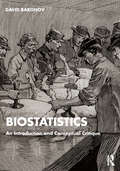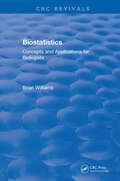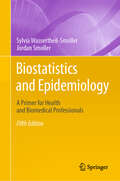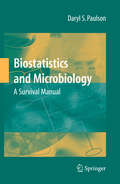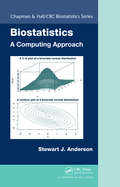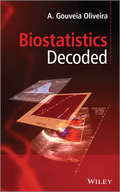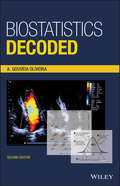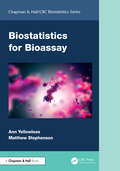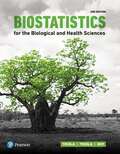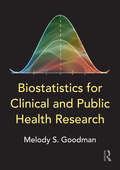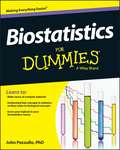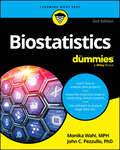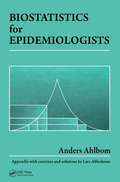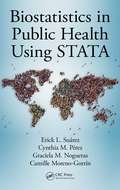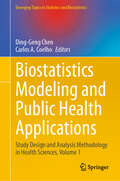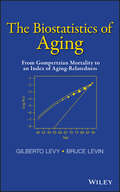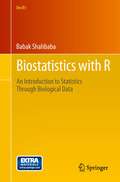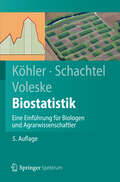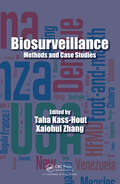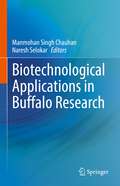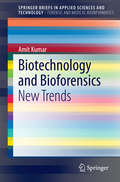- Table View
- List View
Biostatistics: An Introduction and Conceptual Critique
by David BaronovWithout question, biostatistical analysis has contributed to a slew of amazing medical breakthroughs. Yet it also distorts and deforms the holistic and contingent nature of health and medicine. How is it that biostatistics can both sharpen and weaken our understanding of health and medicine? What is unique about the content of health and medicine that so plainly reveals such distortions and deformities? Exploring these questions entails, first, a full survey of the tools and techniques of biostatistical analysis aiding medical breakthroughs. This survey must then be paired with a probe into the conceptual premises of these tools and techniques and how they refashion and reconstitute the inherently qualitative content of health and medicine in preparation for its quantification. We must grasp the statistical machinations at play, both technical and conceptual, that contrive to fit objects to tools rather than fitting tools to objects. This textbook introduces both the procedural methods and the hidden premises of biostatistical analysis.
Biostatistics: A Foundation For Analysis In The Health Sciences
by Wayne W. Daniel Chad L. CrossThe ability to analyze and interpret enormous amounts of data has become a prerequisite for success in allied healthcare and the health sciences. Now in its 11th edition, Biostatistics: A Foundation for Analysis in the Health Sciences continues to offer in-depth guidance toward biostatistical concepts, techniques, and practical applications in the modern healthcare setting. Comprehensive in scope yet detailed in coverage, this text helps students understand—and appropriately use—probability distributions, sampling distributions, estimation, hypothesis testing, variance analysis, regression, correlation analysis, and other statistical tools fundamental to the science and practice of medicine.
Biostatistics: Concepts and Applications for Biologists (CRC Press Revivals)
by Brian WilliamsThis book is a first course in statistics for students of biology. Most of the examples have an ecological bias, but illustrate principles which have direct relevance for biologists doing laboratory work. The structured approach begins with basic concepts, and progresses towards an appreciation of the needs and use of analysis of variance and regression, and includes the use of computer statistical packages. The work is clearly explained with worked examples of real-life biological problems, and should be suitable for undergraduate students engaged in quantitative biological work. Biostatistics should give students a sound grasp of the key principles of biological statistics without overwhelming detail, and should allow students to quickly apply techniques to their own work and data.
Biostatistics and Epidemiology: A Primer for Health and Biomedical Professionals
by Jordan Smoller Sylvia Wassertheil-SmollerThis book teaches foundations of epidemiological design and statistical methods, as well as including topics applicable to new areas of research. Since the publication of the first edition, Biostatistics and Epidemiology has attracted loyal readers from various specialty areas in the biomedical community. The Fifth Edition includes coverage of fixed and random effects and mixed effects models; Poisson regression; constructing confidence intervals for U-shaped relationships; analysis of rare variants; Mendelian randomization; and aspects of machine learning and big data analytics. Biostatistics and Epidemiology was written to be accessible for readers without backgrounds in mathematics. It provides clear explanations of underlying principles, as well as practical guidelines of "how to do it" and "how to interpret it." Key features include a philosophical and logical explanation at the beginning of the book, subsections that can stand alone or serve as reference, cross-referencing, recommended reading, and appendices covering sample calculations for various statistics in the text.
Biostatistics and Microbiology: A Survival Manual
by Daryl S. PaulsonThis "nuts and bolts" book provides a condensation of biostatistical methods that applied microbiology researchers need to perform data analyses. Based on the author's more than two decades of applied research and teaching experience, it is presented in a straight-forward manner, applicable by practicing microbiologists with minimal backgrounds in mathematics. All methods rely only on the use of a basic hand-held calculator. The overriding goal of this book is to ground one's microbiological expertise and experience in one's research pursuits, using biostatistics not as a black box, but as a tool.
Biostatistics: A Computing Approach (Chapman & Hall/CRC Biostatistics Series)
by Stewart AndersonThe emergence of high-speed computing has facilitated the development of many exciting statistical and mathematical methods in the last 25 years, broadening the landscape of available tools in statistical investigations of complex data. Biostatistics: A Computing Approach focuses on visualization and computational approaches associated with both mo
Biostatistics Decoded
by A. Gouveia OliveiraStudy design and statistical methodology are two important concerns for the clinical researcher. This book sets out to address both issues in a clear and concise manner. The presentation of statistical theory starts from basic concepts, such as the properties of means and variances, the properties of the Normal distribution and the Central Limit Theorem and leads to more advanced topics such as maximum likelihood estimation, inverse variance and stepwise regression as well as, time-to-event, and event-count methods. Furthermore, this book explores sampling methods, study design and statistical methods and is organized according to the areas of application of each of the statistical methods and the corresponding study designs. Illustrations, working examples, computer simulations and geometrical approaches, rather than mathematical expressions and formulae, are used throughout the book to explain every statistical method. Biostatisticians and researchers in the medical and pharmaceutical industry who need guidance on the design and analyis of medical research will find this book useful as well as graduate students of statistics and mathematics with an interest in biostatistics. Biostatistics Decoded: Provides clear explanations of key statistical concepts with a firm emphasis on practical aspects of design and analysis of medical research. Features worked examples to illustrate each statistical method using computer simulations and geometrical approaches, rather than mathematical expressions and formulae. Explores the main types of clinical research studies, such as, descriptive, analytical and experimental studies. Addresses advanced modeling techniques such as interaction analysis and encoding by reference and polynomial regression.
Biostatistics Decoded
by A. Gouveia OliveiraBiostatistics Decoded covered a large number of statistical methods that are mainly applied to clinical and epidemiological research, as well as a comprehensive discussion of study designs for observational research and clinical trials, two important concerns for the clinical researcher. In this second edition, new material is included covering statistical methods and study designs that are used to analyse research. Following the same methodology used in the first edition, the chapters are presented in two levels of detail, one for the reader who wishes only to understand the rationale behind each statistical method, and one for the reader who wishes to understand the computations Key features include: Extensive coverage of the design and analysis of experiments for basic science research Experimental designs are presented together with the statistical methods The rationale of all forms of ANOVA is explained with simple mathematics A comprehensive presentation of statistical tests for multiple comparisons Calculations for all statistical methods are illustrated with examples and explained step-by-step. This book presents biostatistical concepts and methods in a way that is accessible to anyone, regardless of his or her knowledge of mathematics. The topics selected for this book cover will meet the needs of clinical professionals to readers in basic science research.
Biostatistics for Bioassay (Chapman & Hall/CRC Biostatistics Series)
by Ann Yellowlees Matthew StephensonIn recent decades, there has been enormous growth in biologics research and development, with the accompanying development of biological assays for emerging products. In parallel, there have been substantial advances in statistical methodology, as well as technological advances in computer power, enabling new techniques to be implemented via statistical software. Biostatistics for Bioassay presents an overview of the statistical analysis techniques that are needed in order to report the results of biological assays. These assays are needed for testing all biological medicines, such as vaccines and cell therapies, to allow them to be released for use. Beginning with consideration of the performance characteristics required of a bioassay, including accuracy, precision, and combinations of these two attributes, the book builds a framework for statistical bioassay design.Features: Explains the statistical methods needed at each stage of the lifecycle of a bioassay Describes the demonstration of the bioassay’s performance, known as validation Covers the statistical techniques for monitoring the bioassay’s performance over time Details how to transfer the bioassay to another laboratory or replace critical reagents Provides examples at every stage, to allow the reader to work through the techniques and consolidate their understanding The book provides a resource for interested bioassay analysts, and statisticians working with bioassays. In bringing together best practices in statistics across the bioassay lifecycle into a single volume, it aims to provide a comprehensive and useful textbook for statistical analysis in bioassay.
Biostatistics for The Biological and Health Sciences
by Marc M. Triola Mario F. Triola Jason RoyReal-world applications connect statistical concepts to everyday life. This book uses a variety of real-world applications to bring statistical theories and methods to life. Through these examples and a friendly writing style, the 2nd Edition ensures that you understand concepts and develop skills in critical thinking, technology, and communication. The result of collaboration between a biological sciences expert and the author of the #1 statistics book in the country, Biostatistics for the Biological and Health Sciences provides an excellent introduction to statistics for readers interested in the biological, life, medical, and health sciences.
Biostatistics for Clinical and Public Health Research
by Melody S. GoodmanBiostatistics for Clinical and Public Health Research provides a concise overview of statistical analysis methods. Use of SAS and Stata statistical software is illustrated in full, including how to interpret results. Focusing on statistical models without all the theory, the book is complete with exercises, case studies, take-away points, and data sets. Readers will be able to maximize their statistical abilities in hypothesis testing, data interpretation, and application while also learning when and how to consult a biostatistician. This book will be an invaluable tool for students and clinical and public health practitioners.
Biostatistics For Dummies
by PezzulloScore your highest in biostatisticsBiostatistics is a required course for students of medicine, epidemiology, forestry, agriculture, bioinformatics, and public health. In years past this course has been mainly a graduate-level requirement; however its application is growing and course offerings at the undergraduate level are exploding. Biostatistics For Dummies is an excellent resource for those taking a course, as well as for those in need of a handy reference to this complex material. Biostatisticians--analysts of biological data--are charged with finding answers to some of the world's most pressing health questions: how safe or effective are drugs hitting the market today? What causes autism? What are the risk factors for cardiovascular disease? Are those risk factors different for men and women or different ethnic groups? Biostatistics For Dummies examines these and other questions associated with the study of biostatistics.Provides plain-English explanations of techniques and clinical examples to help Serves as an excellent course supplement for those struggling with the complexities of the biostatisticsTracks to a typical, introductory biostatistics courseBiostatistics For Dummies is an excellent resource for anyone looking to succeed in this difficult course.
Biostatistics For Dummies
by Monika Wahi John C. PezzulloBreak down biostatistics, make sense of complex concepts, and pass your class If you're taking biostatistics, you may need or want a little extra assistance as you make your way through. Biostatistics For Dummies follows a typical biostatistics course at the college level, helping you understand even the most difficult concepts, so you can get the grade you need. Start at the beginning by learning how to read and understand mathematical equations and conduct clinical research. Then, use your knowledge to analyze and graph your data. This new edition includes more example problems with step-by-step walkthroughs on how to use statistical software to analyze large datasets. Biostatistics For Dummies is your go-to guide for making sense of it all. Review basic statistics and decode mathematical equations Learn how to analyze and graph data from clinical research studies Look for relationships with correlation and regression Use software to properly analyze large datasets Anyone studying in clinical science, public health, pharmaceutical sciences, chemistry, and epidemiology-related fields will want this book to get through that biostatistics course.
Biostatistics for Epidemiologists
by Anders AhlbomBiostatistics for Epidemiologists is a unique book that provides a collection of methods that can be used to analyze data in most epidemiological studies. It examines the theoretical background of the methods described and discusses general principles that apply to the analysis of epidemiological data. Specific topics addressed include statistical interference in epidemiological research, important methods used for analyzing epidemiological data, multivariate models, dose-response analysis, analysis of the interaction between causes of disease, meta-analysis, and computer programs. Biostatistics for Epidemiologists will be a useful guide for all epidemiologists and public health professionals who rely on biostatistical data in their work.
Biostatistics in Biopharmaceutical Research and Development: Clinical Trial Design, Volume 1
by Ding-Geng ChenThe Deming Conference on Applied Statistics has long been deemed an influential event in the biostatistics and biopharmaceutical profession. It provides learning experience on recent developments in statistical methodologies in biopharmaceutical applications and FDA regulations. This book honors 80 years of contributions and dedication of the Deming Conference in biostatistics, and biopharmaceutical clinical trial methodology and applications. All chapters are contributed by world-class and prominent Deming speakers, who've contributed their cutting-edge research and developments to the community. Volume 1 covers Historical Milestones in Clinical Trial Design, FDA biopharmaceutical design guidance, and emerging development in Clinical Trial Design Methodology. This book aims to booster research, education, and training in biostatistics and in biopharmaceutical research and development. Chapter "Response-adaptive Randomization Designs Based on Optimal Allocation Proportion" is available open access under a Creative Commons Attribution 4.0 International License via link.springer.com.
Biostatistics in Biopharmaceutical Research and Development: Clinical Trial Analysis, Volume 2
by Ding-Geng ChenThe Deming Conference on Applied Statistics has long been deemed an influential event in the biostatistics and biopharmaceutical profession. It provides learning experience on recent developments in statistical methodologies in biopharmaceutical applications and FDA regulations. This book honors 80 years of contributions and dedication of the Deming Conference in biostatistics, and biopharmaceutical clinical trial methodology and applications. All chapters are contributed by world-class and prominent Deming speakers, who've contributed their cutting-edge research and developments to the community. Volume 2 covers Biomarkers in Drug Development, Time-To-Event Data Analysis and Methods, and emerging development in biopharmaceutical biostatistics. This book aims to booster research, education, and training in biostatistics and in biopharmaceutical research and development.
Biostatistics in Public Health Using STATA
by Erick L. Suárez Cynthia M. Pérez Graciela M. Nogueras Camille Moreno-GorrínStriking a balance between theory, application, and programming, Biostatistics in Public Health Using STATA is a user-friendly guide to applied statistical analysis in public health using STATA version 14. The book supplies public health practitioners and students with the opportunity to gain expertise in the application of statistics in epidemiolo
Biostatistics Modeling and Public Health Applications: Study Design and Analysis Methodology in Health Sciences, Volume 1 (Emerging Topics in Statistics and Biostatistics)
by Ding-Geng Chen Carlos A. CoelhoThis book provides an overview and compilation of contemporary topics and innovative approaches in biostatistical modeling through their applications to evidence-based public health research and decision-making. This book covers topics in 3 parts as: 1) Biostatistical Modeling, 2) Imaging Data Analysis, and 3) Public Health Applications. Topics should appeal to both expert statisticians, as well as health researchers interested in biostatistical methodological applications in evidence-based health research. The book is a resourceful manual and can be used as an authoritative reference. The features covered in this book will appeal to researchers where public health research is being rigorously conducted.
The Biostatistics of Aging
by Bruce Levin Gilberto LevyA practical and clarifying approach to aging and aging-related diseasesProviding a thorough and extensive theoretical framework, The Biostatistics of Aging: From Gompertzian Mortality to an Index of Aging-Relatedness addresses the surprisingly subtlenotion--with consequential biomedical and public health relevance--of what it means for acondition to be related to aging. In this pursuit, the book presents a new quantitative methodto examine the relative contributions of genetic and environmental factors to mortality anddisease incidence in a population.With input from evolutionary biology, population genetics, demography, and epidemiology, this medically motivated book describes an index of aging-relatedness and also features:Original results on the asymptotic behavior of the minimum of time-to-event random variables, which extends those of the classical statistical theory of extreme valuesA comprehensive and satisfactory explanation based on biological principles of the Gompertz pattern of mortality in human populationsThe development of an evolution-based model of causation relevant to mortality and aging-related diseases of complex etiologyAn explanation of how and why the description of human mortality by the Gompertz distribution can be improved upon from first principlesThe amply illustrated analysis of real-world data, including a program for conducting the analysis written in the freely available R statistical softwareTechnical appendices including mathematical material as well as an extensive and multidisciplinary bibliography on aging and aging-related diseasesThe Biostatistics of Aging: From Gompertzian Mortality to an Index of Aging-Relatedness is an excellent resource for practitioners and researchers with an interest in aging and aging-related diseases from the fields of medicine, biology, gerontology, biostatistics, epidemiology, demography, and public health.
A Biostatistics Toolbox for Data Analysis
by Steve SelvinThis sophisticated package of statistical methods is for advanced master's (MPH) and PhD students in public health and epidemiology who are involved in the analysis of data. It makes the link from statistical theory to data analysis, focusing on the methods and data types most common in public health and related fields. Like most toolboxes, the statistical tools in this book are organized into sections with similar objectives. Unlike most toolboxes, however, these tools are accompanied by complete instructions, explanations, detailed examples, and advice on relevant issues and potential pitfalls - conveying skills, intuition, and experience. The only prerequisite is a first-year statistics course and familiarity with a computing package such as R, Stata, SPSS, or SAS. Though the book is not tied to a particular computing language, its figures and analyses were all created using R. Relevant R code, data sets, and links to public data sets are available from www. cambridge. org/9781107113084.
Biostatistics with R: An Introduction to Statistics Through Biological Data (Use R!)
by Babak ShahbabaBiostatistics with R is designed to mimic the interaction between theory and application in statistics. Topics include data exploration, estimation, and clustering with two appendices on installing and running R and R-commander.
Biostatistik: Eine Einführung für Biologen und Agrarwissenschaftler (Springer-Lehrbuch)
by Gabriel Schachtel Peter Voleske Wolfgang KöhlerDie Auswertung experimenteller Ergebnisse ist für Biologen und Agrarwissenschaftler ein wichtiges Handwerkszeug. Mit dieser gut verständlichen Einführung in Grundlagen und Anwendungen der Biometrie ist ein schneller Einstieg in die Statistik möglich. Soweit wie möglich wird ohne Formeln und mathematische Symbolik die hinter den Verfahren stehende Grundidee komplexer statistischer Verfahren erläutert. Die 5. Auflage enthält zusätzlich Schemata zur Versuchsplanung und Auswertung sowie ein erweitertes Glossar englischer Fachausdrücke.
Biosurveillance: Methods and Case Studies
by Taha Kass-Hout Xiaohui ZhangAs evidenced by the anthrax attacks in 2001, the SARS outbreak in 2003, and the H1N1 influenza pandemic in 2009, a pathogen does not recognize geographic or national boundaries, often leading to devastating consequences. Automated biosurveillance systems have emerged as key solutions for mitigating current and future health-related events. Focusing
Biotechnological Applications in Buffalo Research
by Manmohan Singh Chauhan Naresh SelokarThis book comprehensively reviews the advancements in biotechnological applications for the enhanced production and conservations of buffalo (Bubalus bubalis). The book discusses developments in assisted reproduction to improve productivity and the produce novel products for applications to human health and nutrition. The initial chapters of the book discuss the global distribution and domestications of buffalo, and nutritive values of buffalo milk, while the subsequent sections examine the applications of the genome-wide association traits to identify potential genetic variants affecting important economic traits. It identifies predictive biomarkers for postpartum or peripartum diseased-state and presents potential protein biomarkers for the diagnosis of early pregnancy in buffalo. Lastly, it discusses recent scientific developments such as induced pluripotent stem cells, spermatogonial stem cells, somatic cell nuclear transfer, and buffalo as a model for human biomedical research. This book is a useful source to students, academicians, researchers, and policymakers who are involved in buffalo science and industry.
Biotechnology and Bioforensics: New Trends (SpringerBriefs in Applied Sciences and Technology)
by Amit KumarThis Brief covers broad areas of Applied Biology specifically into the domains of Biotechnology/Biomedicine and Forensic Science. Chapters included here would also explain the role of bioinformatics in protein and gene characterization, modeling of the protein structure, survey related to the chromosomal effect on Human Disorders like Diabetes and Cardiac Problems. This Brief is full of Innovative Literature like Use of Microbes in Electricity Production, Brain connection to Type 2 Diabetes etc. Interesting issues in Forensic biology and the aspects of Bioforensics like STR profiling of exhumed bones makes this brief truly useful and informative for Researchers. It also includes the advancements and new ideologies in understanding crop improvements & crop quality. This Brief witnesses Innovative Research related to the Bio and Agri software development too which are capable of accelerating Insilico biological data analysis.
